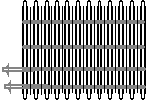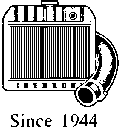AutoTips Auto Heater Tips page
Car heater chilled out?
Use caution when working around radiator & heater, hoses and coolant. They can be very hot. Never open the radiator cap when the engine is hot, antifreeze / water can spray out. Use of safety goggles is suggested.
TIP: With a rag or glove to protect your hands from being
burned, gently squeeze radiator hose to check for pressure before opening
the radiator cap.
A few tips troubleshooting your car heater. The
most common problem is low engine coolant level and/or low engine temperature.
Temperature from the heater outlets should be 130 degrees or more
with the fan on high after the car has warmed up. In cars five years
old or newer is the most common problem is a faulty engine thermostat.
The older the vehicle, the more likely problems are the heater core and
/ or multiple other problems.
 Note
the connections on the heater core for hoses to the engine.
Note
the connections on the heater core for hoses to the engine.
A heater core works like the car radiator. Coolant from the engine circulates
through the core, air blows through the core and into the passenger compartment.
Heater cores can become plugged, and may require flushing or replacement.
Two hoses go from the the engine to the heater core, and can develop pin-hole
leaks that only show up under pressure, as when the engine is hot. Flush
kits are available from auto parts stores to use a garden hose to flush
the heater core and radiator.
If the engine temperature and fluid level are correct, the next most common problem is poor circulation through the heater core. With the motor running and at full operating temperature, CAREFULLY feel the heater hoses. (Use of a rag may help protect hands) Both hoses should be similar in temperature. If one hose is considerably cooler then the heater is restricted. Flushing the heater works sometimes but replacement is often necessary.
![]() Depending
on the vehicle, the temperature control lever may control a water valve
in series with the heater core, or an air door that mixes hot and cold
air. The lever may operate via wire cable or vacuum controls. There
can be problems in the control valve, cable, vacuum line, or vacuum diaphragm
( sometimes called a vacuum motor ) that controls air doors.
Depending
on the vehicle, the temperature control lever may control a water valve
in series with the heater core, or an air door that mixes hot and cold
air. The lever may operate via wire cable or vacuum controls. There
can be problems in the control valve, cable, vacuum line, or vacuum diaphragm
( sometimes called a vacuum motor ) that controls air doors.
Remember for good heat you need hot water and air flow so start with the basics and you'll most likely find the problem. Heater cores on some cars can be difficult to replace, taking your vehicle to a good radiator repair shop may be in order.
These tips courtesy of .
 Indianapolis
Radiator Works
Indianapolis
Radiator Works
New - Custom - Automotive - Truck - Industrial
Radiators
Repairing, Recoring, Industrial, Commercial radiators.
Wholesale & Retail
Shipping available.
108 S. Rural St.
Indianapolis, IN 46201
317-634-6315
1-800-RAD0540
( Please mention you saw the article on the internet when calling Indianapolis
Radiator Works. )
Return to Tips page Return to AutoTips home page